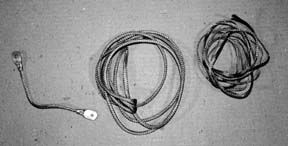We have often mentioned RFI and EMI in our tests of common electronic devices such as battery chargers. We decided it was time to discuss options to combat, or better yet, avoid these problems altogether.
The effects of RFI/EMI often are merely an annoyance, such as interference on a TV screen. At other times, however, the problem can be very severe, such as an autopilot that begins a 180 turn every time the SSB (single-sideband radio) transmits.
There is a systematic way to approach this problem, and we will cover the basic evaluation process, step by step. Entire books have been dedicated to this subject!
What is RFI/EMI?
RFI stands for radio frequency interference, and is manifested by any radio frequency interactions that adversely affect equipment operation. Any electronic device, as well as some less obvious sources, can cause it.
EMI is electromagnetic interference and is a very broad term that covers all electronic interactions from RFI to electrostatic discharge to electronic fields such as those found around power lines. It also includes audio frequency sources, such as induced hum from transformers. A common example is the disruption caused by the generation of magnetic waves by an unshielded electronic device in close enough proximity to a compass.
Transformers are an excellent source of EMI and are found in many devices such as battery chargers, inverters, or even 12-volt fluorescent lighting. We recently installed a fluorescent light on a computer monitor that was expressly designed for this location. When we turned on the light, however, the top section of the computer screen started to shimmer. Obviously the lights transformer generated EMI and had insufficient magnetic screening built in.
The lesson here is that even if you follow the rules you sometimes can have problems, so the best time to check your systems is immediately following installation of new gear.
Secondly, if you stick with good quality equipment and components, you are far less likely to have problems. The light we bought was cheap and it showed. Proper equipment selection is part of a systematic approach to reduce the time and frustration RFI and EMI can cause.

RFI comes in two basic flavors. The first, conduction, is where interference flows through common electrical wiring such as power lines. This can be troubling if the boat docked next to you sharing the same AC dock power line has some bad equipment (such as a battery charger) putting out RFI. This RFI can easily flow right to your electrical system AC wiring.
The second type of RFI is radiation or broadcasting of the interference through the air to anything that can act as an antenna such as equipment wiring that is not shielded. Distance has a pronounced effect on radiated interference, and sometimes only a few feet of separation can help tremendously. This interference can come from obvious sources such as transmitters, but also less obvious things such as loose rigging or a spinning prop shaft causing static electricity.
New equipment is not always the problem. For example, coax cable breaks down with time, weathering and vibration, and may leak RF energy. Sometimes RFI comes from sources external to the boat, but the cures are similar.
Some equipment is less susceptible to RFI, such as FM equipment to static. On the other hand, FM is susceptible to power supply voltage fluctuations as well as alternator noise. Other equipment, such as AM equipment like SSB, is especially sensitive to just about anything.
At times, RFI can be very subtle, showing up as a reduced signal-to-noise ratio on Loran receivers.
Whenever possible, it is far more effective to prevent RFI in the first place than to deal with the aftereffects. Use only quality equipment, designed for the marine environment, that meets regulatory, governmental or testing agency marine standards such as U.S. Coast Guard, FCC (Federal Communications Commission), UL (Underwriter Laboratories, and CE (European Union standards).
Avoiding RFI/EMI
A common type of RFI is called fundamental overload, in which a receiver cannot reject strong unwanted RF fields. The effect is directly proportional to the strength, which drops as the square of the distance. Thats why only a small incursion of an antenna into another antennas transmitting field can make a big difference. So, if the installation directions say to mount a particular antenna no closer than 6′ to other antennas, mounting it at 5′ can make a big (and adverse) difference.
The rusty bolt effect is a cute, causal term for what can be very frustrating and mysterious RFI to track down. RF flowing through any nonlinear junction such as corroded joints in stays or coax antenna connectors-even poor solder joints-can rectify the RF and cause harmonics in the crude diode formed from the bad joint. The best way to combat this problem is to keep up with maintenance and avoid corrosion in the first place.
There are several important steps to take which may seem painfully obvious but are among the most common reasons for trouble-even when you are installing the best equipment. From time to time we are all guilty of not following installation instructions, because it can be a pain to chase down the correct components. Failing to do so can be a huge time sink, however
In addition to proper antenna placement, another common problem is substitution of incorrect installation materials. If directions say to use a shielded power wire, standard wire is not okay even though you probably do not have shielded wire handy. If directions say to twist leads together along their length-do so to prevent inductive pick-up. Its the darn little details that can get you. The installation will probably appear to work fine until you discover what it does to surrounding equipment.
An area that is the cause of RFI as well as general electrical problems is improper grounding and bonding. Grounding equipment any place handy tends to set up what are called ground loops or pockets of a very slight difference in potential (voltage) between equipment. This is not easy to check with a multimeter, because youre dealing with fractions of an Ohm-tiny but enough to cause trouble. Bonding your equipment together helps keep everything at the same voltage potential, reducing static pick-up, and, as an additional benefit, also reducing stray current corrosion.
If you notice RFI starting without any new installations, be wary of equipment breakdown. There may be, for example, component deterioration inside a receiver. Internal wiring can fatigue, or if the chassis has been opened it may have been put back together improperly and can leak RF. Routine maintenance can loosen wires-particularly grounds that only get worse as corrosion develops at the loose connection. Even existing filters/capacitors can break down. Two other prime candidates for RFI are deteriorating coax cable (its extremely important to use 95% tinned braid or youll have trouble right away with shield leakage), and spark plug wires that leak RF. Spark plug wires take a real electrical beating, so changing them at two-year intervals is good preventative maintenance in avoiding RFI. Be sure to use the best resistance type wire and resistor type spark plugs. In extreme cases, a continuous metal braid shield may be required on the wires. This is a common practice on aircraft where RFI is intolerable.
Dealing With RFI/EMI
Okay, you have been diligent about trying to prevent RFI but you develop a problem. This is where a systematic approach helps, aided by a cheap AM radio that acts as an RF sniffer. Tune the radio to a vacan’t spot low on the dial and move it around equipment suspected of causing RFI. The nature and location of the sound will provide some clues. One of the most common and distinguishable sounds is alternator whine that sounds like a howl or whistle on the speaker, changing pitch with the speed of the alternator. Popping noises come from ignition systems, such as spark plug wires, coils and voltage regulators (particularly the mechanical kind).
Inexpensive filters in the form of 1mF, 200-volt capacitors in places such as the ignition switch terminal on the coil wire or alternator output wire can work wonders. On the typical case-grounded alternator add a separate, wide ground strap to the block or common ground point. Additionally, an in-series capacitor rated at full alternator output can prove helpful, but costs about $50.
A 1 mF capacitor can also help when installed between the voltage regulator/battery connection to ground (see schematic on page 11). All leads should be as short as possible.
Ultimately, if simple filters fail, screen shielding may be required over equipment such as alternators. Aluminum foil tape can help if a chassis is leaking RF. If possible, make one change at a time to see if that solves the problem. If not, leave the fix in place and add another cure.
Frequently, RFI has multiple causes, so multiple cures have to be used. There are two classes of RFI called differential mode interference and common mode interference. The only thing you have to remember is that if they both occur, which is common, they require different solutions, meaning at least two fixes.
If coax cables are run together in parallel, any leaking of RF in one cable can interfere with others. The RF leaks out through physical damage caused by wear or age or poor connectors. Even failing to solder all four solder holes on a solder-type coax connector can leak RFI. The energy runs along the outside braid to do all kinds of mischief. Keeping coax connectors to an absolute minimum is very helpful in reducing RFI and can improve radio performance as well. Using good quality crimping tools with crimped connectors are essential to prevent RFI and insure good performance.
A particularly effective and underutilized cure is the use of ferrite chokes, sometimes called torroids. The neat thing is that they do not require any cutting or soldering. They come in multiple forms and work in different ways depending on the wiring, but the important thing is that they absorb or cancel unwanted RFI. Two common uses are on power lines and coax cables. Some forms simply snap on the cable, and others need the cable looped through. There are actually a number of ferrite materials optimized for different frequencies. If you are interested in the details, an excellent book is the RFI Handbook from the American Radio Relay League, dedicated to dealing with many forms of RFI. It costs $20. Be advised, however, that its a little heavy on the techno-speak. The diagrams are very helpful, however. The book only covers homes and autos, but the concepts are the same.
Power line filters are sometimes needed in addition to ferrite chokes (this gets back to common mode interference and differential mode interference). These filters contain inductors and capacitors that act as low pass filters for 60 Hz, but block RFI. They need to be rated at the power consumption of the device they are plugged into-higher for motors with a starting load greater than running load.
Filters are best used at the offending device end, rather than the receiver end, although sometimes filters are needed at both ends. Thats why its so important to avoid RFI in the first place, otherwise you can end up with filters everywhere.
Contacts- General Filters, Radio Shack, 1 Tandy Center, Ste. 300, Ft Worth TX 76102; 800/843-7422; www.radioshack.com. Ferrite chokes, Amidon, Inc., 240 Brigs Ave., Costa Mesa CA 92626; 714/850-1163; www.amidoncorp.com. Low, high, and band pass filters, Vectronics, 921 Highway 25S, Starksville, MS 39758; 800/363-2922; www.vectronics.com. AC line filters, Electronic Specialists, Inc., 171 S Main St., Natic, MA 01760; 508/653-0268; www.elect-spec.com. Alternator filters, Defender, 42 Great Neck Rd., Waterford, CT 06385; 800/628-8825; www.defenderus.com. The ARRL R.F.I. Book, Universal Radio, 6830 Americana Pkwy., Reynoldsburg, OH 43068; 800/431-3939.





































